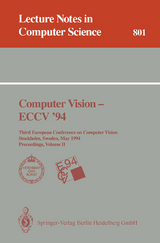Computer Vision - ECCV '94
Springer Berlin (Verlag)
978-3-540-57957-1 (ISBN)
Active object recognition integrating attention and viewpoint control.- Active 3D object recognition using 3D affine invariants.- Grasping the apparent contour.- Visual tracking of high DOF articulated structures: An application to human hand tracking.- Integration and control of reactive visual processes.- Motion estimation on the essential manifold.- Motion from point matches using affine epipolar geometry.- Navigation using affine structure from motion.- A paraperspective factorization method for shape and motion recovery.- Active camera self-orientation using dynamic image parameters.- Planning the optimal set of views using the Max-Min principle.- On perceptual advantages of eye-head active control.- Improving registration of 3-D medical images using a mechanical based method.- Non-iterative contextual correspondence matching.- A registration method for rigid objects without point matching.- Non-parametric local transforms for computing visual correspondence.- Measuring the affinetransform using gaussian filters.- Extracting the affine transformation from texture moments.- Lack-of-fit detection using the run-distribution test.- Disparity-space images and large occlusion stereo.- Registration of a curve on a surface using differential properties.- Genetic algorithms applied to binocular stereovision.- Segmentation of echocardiographic images with Markov random fields.- Unsupervised regions segmentation: Real time control of an upkeep machine of natural spaces.- Synchronous image restoration.- Parameterfree information-preserving surface restoration.- Spatially varying illumination: A computational model of converging and diverging sources.- Recovery of illuminant and surface colors from images based on the CIE daylight.- 3-D stereo using photometric ratios.- Shape from shading: Provably convergent algorithms and uniqueness results.- Seeing beyond Lambert's law.- Using 3-dimensional meshes to combine image-based and geometry-based constraints.- Determination ofoptical flow and its discontinuities using non-linear diffusion.- Motion boundary detection in image sequences by local stochastic tests.- Segmentation of moving objects by robust motion parameter estimation over multiple frames.- Stochastic motion clustering.- Association of motion verbs with vehicle movements extracted from dense optical flow fields.- Comparisons of probabilistic and non-probabilistic hough transforms.- Markov random field models in computer vision.- The role of key-points in finding contours.- A framework for low level feature extraction.- Rigid and affine registration of smooth surfaces using differential properties.- The quadric reference surface: Applications in registering views of complex 3D objects.- Relative 3D regularized B-spline surface reconstruction through image sequences.- Intrinsic stabilizers of planar curves.- Affine and projective normalization of planar curves and regions.- Area and length preserving geometric invariant scale-spaces.- Invariants of 6 points from 3 uncalibrated images.- A common framework for kinetic depth, reconstruction and motion for deformable objects.
| Erscheint lt. Verlag | 20.4.1994 |
|---|---|
| Reihe/Serie | Lecture Notes in Computer Science |
| Zusatzinfo | XV, 488 p. |
| Verlagsort | Berlin |
| Sprache | englisch |
| Maße | 155 x 233 mm |
| Gewicht | 630 g |
| Themenwelt | Informatik ► Grafik / Design ► Digitale Bildverarbeitung |
| Mathematik / Informatik ► Informatik ► Software Entwicklung | |
| Informatik ► Theorie / Studium ► Künstliche Intelligenz / Robotik | |
| Schlagworte | 3D • affine transform • Bildverarbeitung • Cognition • computer vision • Computervision • Epipolar Geometry • Genetic algorithms • Hardcover, Softcover / Informatik, EDV/Informatik • HC/Informatik, EDV/Anwendungs-Software • HC/Informatik, EDV/Informatik • Multimedia • Mustererkennung • Navigation • Object recognition • optical flow • Planar • proving • Shading • Stereo • Textur • Tracking |
| ISBN-10 | 3-540-57957-5 / 3540579575 |
| ISBN-13 | 978-3-540-57957-1 / 9783540579571 |
| Zustand | Neuware |
| Haben Sie eine Frage zum Produkt? |
aus dem Bereich




